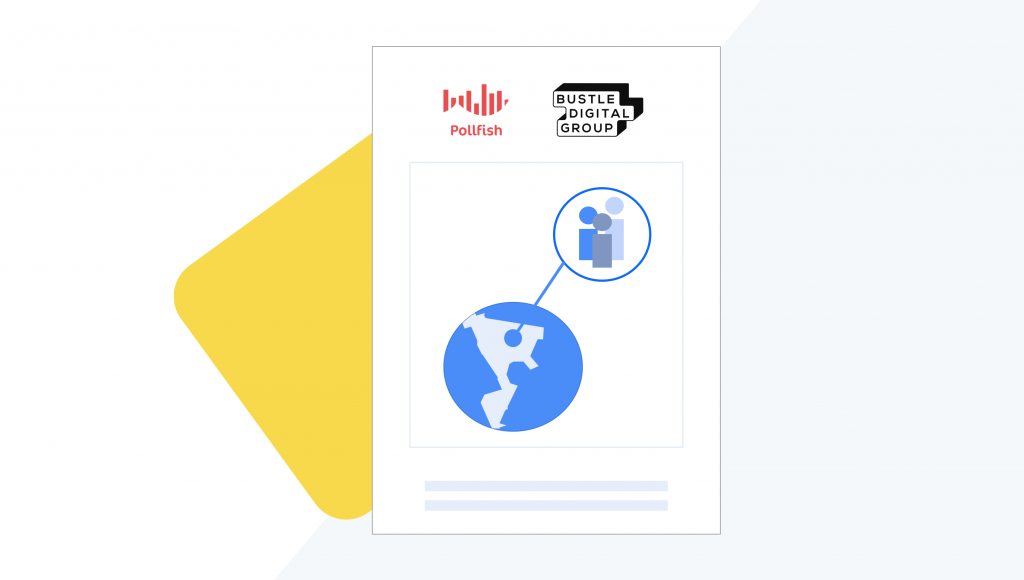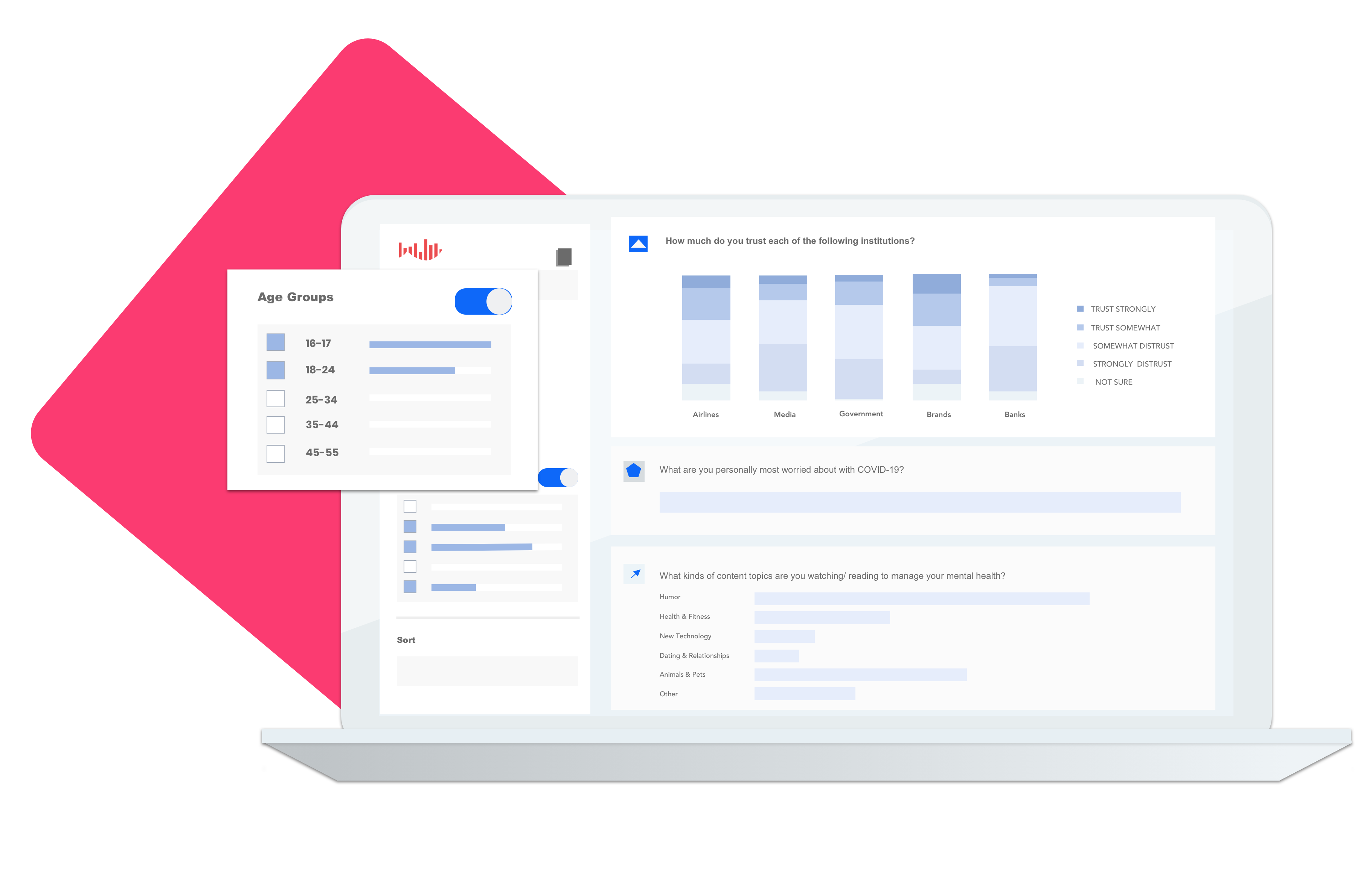How Bustle reached niche survey audiences with Pollfish

Reaching niche audiences is a tough challenge for any brand. And it has become more important than ever.
Reaching the right audience
Today’s consumer expects personalization and is seeking products, services, media, and more that fit their interests. With search engines and social media platforms that deliver more precisely every day, brands who know their niche audiences will have a distinct advantage over those who don’t.
Unfortunately, reaching these audiences is no easy task. For one thing, traditional methods of collecting opinions may not work as well for smaller or harder-to-find demographics. Survey panels are limited, homogeneous, and demographically inconsistent, especially on larger, more comprehensive surveys.
Technology presents new challenges. When trying to reach people who are savvier when it comes to technology, there are new considerations that a researcher must account for, especially when trying to reach younger “digital native” respondents.
From respondent experience to methodology to the types of questions you write, researchers must, to a certain extent, earn participation by building surveys that suit their niche audiences.
For a media company like Bustle Digital Group–which owns eight publications, all targeting niche audiences and all working to establish their brand voice and vision–the challenge is even tougher. Every brand decision they make as a parent company needs to consider the interests of all publications below, and vice versa.
This is the story of how Bustle used Pollfish to meet this challenge for its editorial staff, clients, and advertisers, all under the stress of a global pandemic.
Bustle’s Target Audience
With local news stations and newspapers across the country falling out of favor with consumers over the last 10 years, the brands that have survived have discovered new ways to deliver content and target it to their most valuable consumers.
Surveys have repeatedly shown that these preferences are changing fastest among women, especially women 18-24, or Gen Z.
Young people between 18-24 prefer to get their news from social media and receive it in more audio/visual forms like video, maps, interactive infographics, and podcasts.
These new forms of news delivery are especially popular among women, who today prefer to get their news through either word of mouth or social media.
These insights have driven the success of Bustle Digital Group since its founding in 2013. With 8 publications, all targeting niche audiences of Millennials, GenZ, and Women, BDG has set itself apart by using research to discover the wants and needs of its audiences and deliver traffic and insights to clients and advertisers.

How Pollfish Helped
When COVID-19 hit earlier this year, BDG leaders were faced with a unique challenge–finding out what their diverse, underserved audience would want to read during a pandemic. What would their role be?
Bustle had some unique challenges. For a start, they needed to work quickly. With COVID-19 news breaking every day and 8 publications in need of editorial direction, they needed to reach their varied target audiences quickly.
Mobile surveys
For traditional survey platforms and panels, that could be a problem. Gen Z is a notoriously difficult group to survey. Gen Z typically doesn’t join panels proactively. Traditional methods of gathering respondents–email, social media, digital ads–get very low participation rates from digital natives, who have been advertised to in this way their entire lives.
Pollfish reaches respondents inside mobile apps, allowing more access to more people, including digital natives and people who would otherwise be too busy to complete a survey. By taking advantage of Pollfish’s ability to provide the convenience of completing surveys on devices, Bustle can reach a larger and more diverse audience.
Younger Audiences
When trying to reach younger members of Gen Z, most panels don’t enlist consumers under 18 years of age. But because Pollfish provides surveys to users inside mobile apps, we can collect responses from real consumers in real-time, as young as 16 years of age, and remain compliant with all global privacy laws.
And because Pollfish can deliver surveys to anyone who has downloaded an app within the Pollfish App Network, Bustle was able to choose from a network of over 700 million respondents worldwide, targeting down to the zip code, custom age ranges, and detailed demographics.

How Bustle Used Their Data
Using advanced targeting from Pollfish, Bustle could slice the data to build samples similar to the readership of each of their publications.
In March, Bustle created a survey of 2000 respondents. They targeted age groups between 16 and 44, with a nearly even split between males and females. Their goal was to better understand how millennials and Gen Z were feeling about the COVID-19 crisis. Bustle’s Associate Director of Research and Insights Dani Thibodeau had this to say:
“Whenever we create surveys, our first question is: what are we trying to learn? In that question, there’s usually a demographic included (i.e. how are Gen Z’s and millennials handling the pandemic differently?). That then informs how we are segmenting the survey and setting quotas so we can paint the most accurate picture in answering the question we’ve posed as our research objective.”
Bustle appreciated the ability to reach real consumers in real-time. They could then use this data to inform content decisions and deliver branded insights to clients and advertisers.
“Being able to reach real people about real issues just feels like a more accurate depiction of who our audience actually is,” Dani said.
For their study with the Clinton Foundation, Bustle took this niche segmentation even further. They were able to segment out essential workers, stay-at-home moms, moms newly working from home due to COVID, and moms who have recently been laid off due to COVID.
This detailed segmentation yielded some exciting results.
“An insight we found interesting was that overall, participants said there was not more tension with their partner during this difficult time,” Dani told us. “In fact, essential workers mentioned a more equal distribution of work in the household. We also discovered that working moms were spending several hours daily on planning educational activities for their children — on top of the work they were doing for their jobs.”
Reassuring Clients & Advertisers
When the COVID-19 crisis began, clients and advertisers were understandably concerned. How would they be able to meet the needs of their customers and avoid tone-deaf messaging and initiatives?
Many of these brands turn to Bustle to reach Millennial and Gen Z audiences. Dani told us how Bustle delivered helpful insights.
“Brands and advertisers look to us as experts in the millennial and Gen Z landscape. By doing custom research we can share what’s on the minds of these sought-after audiences — what they want from brands, what’s most important to them, what kinds of actions/messaging resonate best with them.”
This research delivered insights that helped brands excite and engage their customers while being sensitive to feelings around this public health crisis.
“We noticed early on that brand actions speak louder than words. As many brands changed messaging to “we’re all in this together”, Gen Z didn’t want to hear it unless there was a plan of action behind the messaging, like donating to causes, setting up relief funds for impacted communities, and using their resources to manufacture PPE and other necessary supplies.”
John Steele
Ready to Try Pollfish?
Create your survey with AI, target high-quality respondents starting at $0.95 per complete, and start getting results in just minutes in real-time. From running a simple product concept survey to managing a constant stream of trackers for dozens of clients in dozens of countries, we’ve got you.
